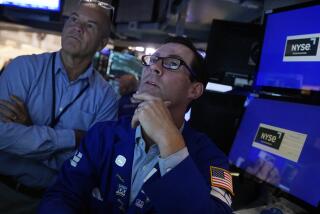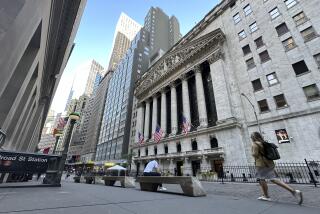Dollar Mixed in Profit Taking, Rumors of Revised Trade Rules
NEW YORK — The raging value of the dollar turned mixed Tuesday as dealers took profits from its recent strength and speculated on what the United States and its trading partners might do next to stabilize foreign exchange rates.
Traders reported increased dollar selling by the Federal Reserve and central banks of Britain and Japan, but they said the market once again ignored the interventions.
“The market is sort of catching its breath here . . . but there’s still very strong sentiment behind the dollar, even though we’re seeing a pause right now,” said William P. Sterling, an international economist with Merrill Lynch Capital Markets.
The dollar’s slight retrenchment dollar against some other key currencies helped to push up most interest rates in the credit markets and to weaken stock prices, analysts said.
Gold prices were mixed in the United States, although they regained some of the steep losses overseas that stemmed from a rally of the dollar Monday. The price of an ounce of gold fell $2.65, to a late bid of $361.85 an ounce, according to the Republic National Bank of New York.
The dollar started out strong in overnight trading and closed at another recent high in Tokyo, but fell against most currencies in Europe and was mixed in the United States due to profit taking and speculation that Japan and the United States might change their credit policies.
Traders speculated that the Bank of Japan would soon raise its discount rate, the interest it charges on loans to commercial banks, and that the Fed might ease U.S. rates, both to stem the dollar’s rise.
The market was also rife with rumors that a currency stabilization initiative would be undertaken by the Group of Seven, the United States and its six major trading partners.
In Washington, the Bush Administration reaffirmed its pledge to keep exchange rates steady and speculation emerged that the Federal Reserve might soon start to lower interest rates.
A day after the White House expressed concern that the surging dollar could damage U.S. trade prospects, Secretary of State James A. Baker III said Washington was committed to working closely with its allies on economic policy and exchange rates.
“I think it’s important that the major industrial democracies of the world continue to work to coordinate their economic policies,” Baker said. “It’s really the coordination of those underlying economic policies that’s going to make a difference in terms of exchange rate stability.”
Bush’s chief economic adviser, Michael J. Boskin, also sought to end speculation that the Administration was willing to tolerate a stronger dollar, which reached a 29-month high against the West German mark this week.
“The Administration has not changed its policy,” Boskin told reporters.
The dollar rose sharply on Monday. It broke the 2-mark level for the first time in 2 1/2 years and reached a 1 1/2-year high in relation to the yen, due largely to a perceived weakness in foreign-exchange policies among the Group of Seven.
“The dollar cannot turn around until there are policy changes on either side of the water,” said Ronald H. Holzer, chief currency dealer with Harris Trust & Co. in Chicago. “Until then, we’ll be trading off the rumors.”
Fed governor H. Robert Heller said, however, that inflation remained “a key factor to be considered in monetary policy making,” and he gave no indication the Fed was considering easing rates to depress the dollar.
On Tuesday, the government reported that durable goods orders shot up 2.9% in April, the best showing in four months and a further indication of U.S. economic strength.
In London, the British pound dropped to $1.5675 from $1.5810 late Monday--a 22-month low--despite intervention by the Bank of England. Sterling fetched $1.5645 in New York, up from $1.5755.
In Tokyo, where trading ends before Europe’s business day begins, the dollar rose by 1.50 Japanese yen and closed at 141.95 yen, despite intervention by the Bank of Japan for the second consecutive day. In London it traded at 141.60 yen. Later, in New York, it traded at 142.30 yen, up from 142.05 yen on Monday.
Other late dollar exchange rates in New York, compared to Monday’s: 2.0110 West German marks, down from 2.01175; 1.7915 Swiss francs, down from 1.7935; 1.19945 Canadian dollars, down from 1.20125; 6.8100 French francs, down from 6.8115, and 1,457.50 Italian lire, up from 1,456.50.
On the New York Commodity Exchange, gold bullion for current delivery rose to $363.80 an ounce.
More to Read
Inside the business of entertainment
The Wide Shot brings you news, analysis and insights on everything from streaming wars to production — and what it all means for the future.
You may occasionally receive promotional content from the Los Angeles Times.










